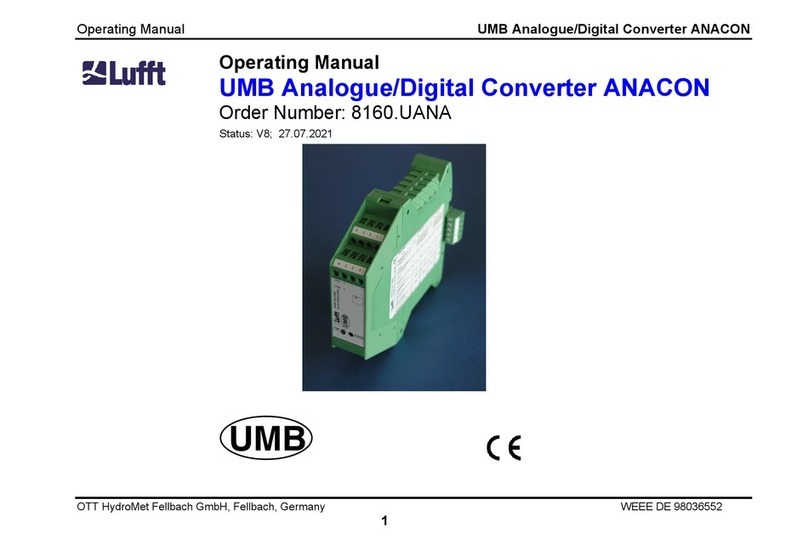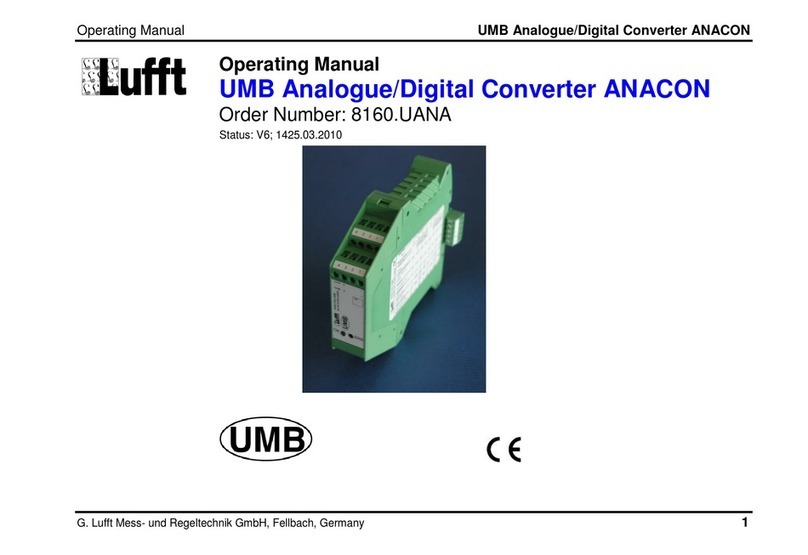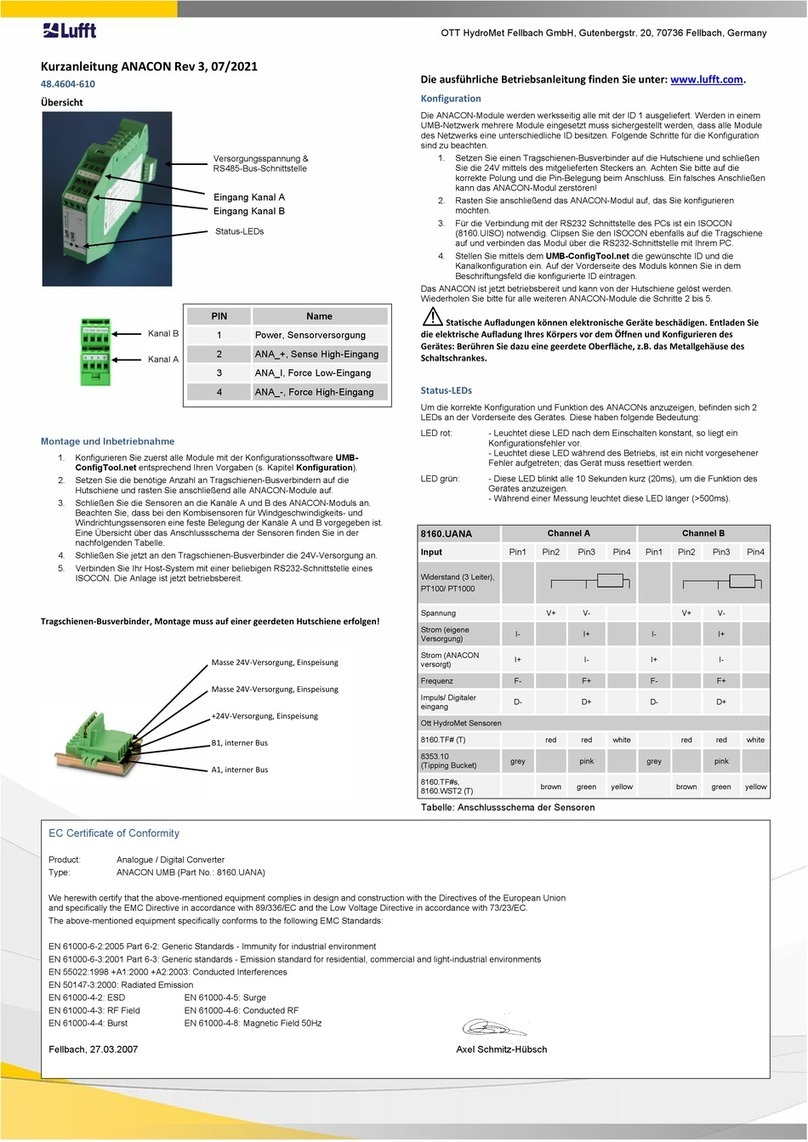
Kurzanleitung ISOCON V2
UMB ISO-Wandler ISOCON
Übersicht
Sensor Versorgung und RS485 Sensor-Anschluss
SS3-2
Pin 1: +12V Versorgungsspannung für alle 12V-Sensoren
Pin 2: GND1 galvanisch getrennte Masse für alle 12V-Sensoren
Pin 3 +24V schaltbare Versorgungsspannung für alle 24V-Sensoren
Pin 4: GND2 Masse für alle 24V-Sensoren
SS3-1
Pin 1: A 2-Draht-RS485 A,
Pin 2: B 2-Draht-RS485 B
Pin 3: A 2-Draht-RS485 A, intern gebrückt mit Pin 1
Pin 4: B 2-Draht-RS485 B, intern gebrückt mit Pin 2
Bei langen Leitungen (>300m) wird ein Abschlusswiderstand von ca. 120 Ohm zwischen
A- & B-Klemmen empfohlen.
Tragschienen-Busverbinder, Montage muss auf einer geerdeten Hutschiene erfolgen!
Montage und Inbetriebnahme
1. Konfigurieren Sie zuerst alle Module entsprechend Ihren Vorgaben.
2. Clipsen Sie die benötigte Anzahl an Tragschienen-Busverbindern auf die
Hutschiene und rasten Sie anschließend alle ISOCON-Module auf.
3. Schließen Sie je einen UMB-Sensor an ein ISOCON-Modul an. Beachten Sie die
unterschiedlichen Spannungsbereiche (12V/24V) der UMB-Sensoren und
achten Sie auf die korrekte Polung bei der Versorgung und der Busverbindung.
4. Schließen Sie jetzt an den Tragschienen-Busverbinder die 24V-Versorgung an.
5. Verbinden Sie Ihr Host-System mit einer beliebigen RS232-Schnittstelle eines
ISOCON oder mit der RS485 eines zusätzlichen ISOCON-Wandlers. Beachten Sie
für diesen Fall, dass die Host-Kommunikation dieses ISOCON-Wandlers auf
RS485/2D gestellt werden muss. Die Anlage ist jetzt betriebsbereit.
Ein ausführliches Manual finden Sie unter: www.lufft.de
Konfiguration
Entriegeln Sie für die Konfiguration rechts und links den Gehäusekopf (s. Abb. 1.). Ziehen
Sie die Leiterplatte bis zum Anschlag aus dem Gehäuse heraus. Stellen Sie an den beiden
DIP-Schaltern (s. Abb. 2) die gewünschte Konfiguration, entsprechend den
nachfolgenden Tabellen für DIP1 und DIP2 ein. Schließen Sie bitte anschließend das
Gehäuse (Gehäusekopf und Gehäuseunterteil müssen zusammen einrasten) und
montieren Sie den ISOCON auf dem Tragschienen-Busverbinder.
Statische Aufladungen können elektronische Geräte beschädigen. Entladen Sie
die elektrische Aufladung Ihres Körpers vor dem Öffnen und Konfigurieren des
Gerätes: Berühren Sie dazu eine geerdete Oberfläche, z.B. das Metallgehäuse des
Schaltschrankes.
Abb. 1: Entriegeln Gehäusekopf Abb. 2: DIP-Schalter
DIP1 : Host-Kommunikation konfigurieren
1) Hostkommunikation: RS232, Baudrate 19200 Baud
2) Mit diesen Baudraten ist kein Firmwareupdate der UMB-Sensoren möglich!
3) Wird die Funktion „Watchdog RS232“ aktiviert, überwacht der ISOCON den Datenverkehr auf der RS232
Schnittstelle. Erfolgt für mehr als 45 Minuten keine Datenabfrage, wird abhängig von DIP2 der 12V/24V
Ausgang resetiert. Mit Hilfe dieser Funktion kann z.B. ein Modem resetiert werden.
DIP2 : Modi konfigurieren
Die Tabelle zeigt eine Übersicht mit den unterschiedlichen Einstellungen.
1) Resetfunktionen 12V/24V aktiviert.
2) Funktion zur Zeit nicht verfügbar.
3) Schaltet die 12V-Versorgung zyklisch Ein/Aus, wenn keine Kommunikation zum Sensor möglich ist.
4) Schaltet die 24V-Versorgung zyklisch Ein/Aus, wenn keine Kommunikation zum Sensor möglich ist.
X : beliebige Stellung möglich
Status-LEDs
LED rot: - Leuchtet diese LED nach dem Einschalten konstant, so liegt ein
Konfigurationsfehler vor. DIP-Schalter überprüfen
- Leuchtet diese LED während des Betriebs, ist die Resetfunktion zur
Unterbrechung der Sensorversorgung aktiviert.
LED grün: - Diese LED blinkt alle 10 Sekunden kurz (20ms), um die Funktion des
Gerätes anzuzeigen.
- leuchtet diese LED länger (>500ms), werden Daten von dem
angeschlossenen Sensor empfangen.
Diagnose-Modus, nur für
internen Gebrauch
Automatisches Routing *2)
Diagnose-Modus, nur für
internen Gebrauch
Sensor-Spannungsausgang 12V/24V (SS3-2)
RS485-Sensor-Schnittstelle (SS3-1)
Versorgungsspannung &
RS485-Bus-Schnittstelle
Sensor-Spannungsausgang 12V/24V (SS3-2)
RS485-Sensor-Schnittstelle (SS3-1)
Masse 24V-Versorgung, Einspeisung
Masse 24V-Versorgung, Einspeisung
+24V-Versorgung, Einspeisung
B1, interner Bus
A1, interner Bus






















